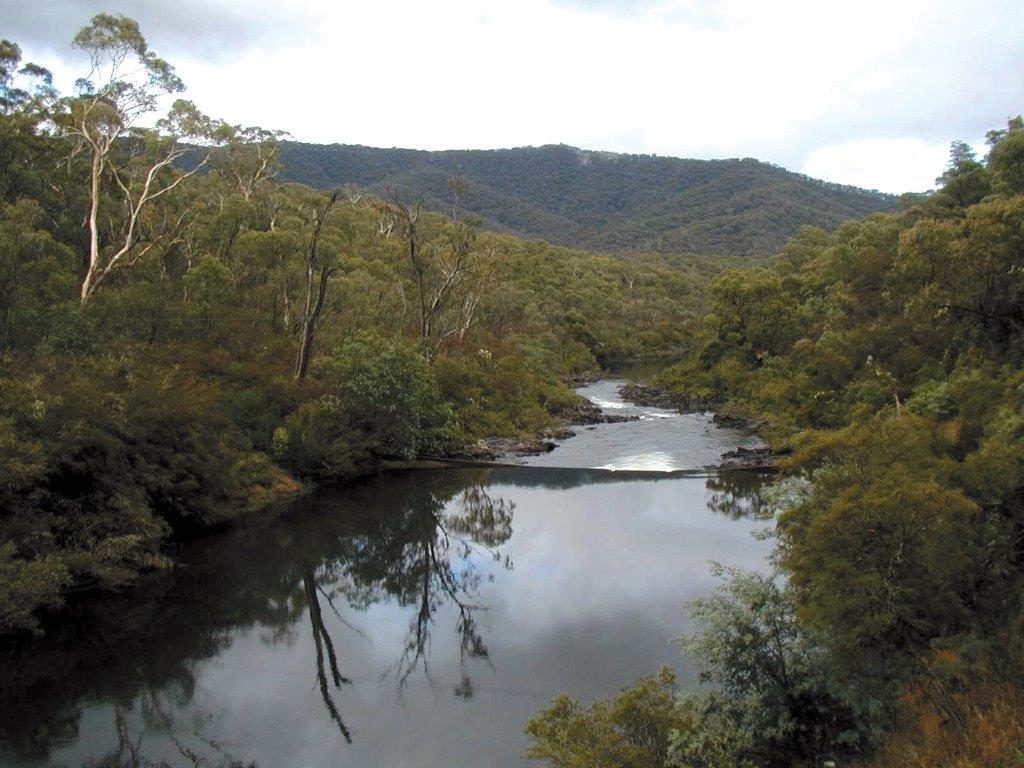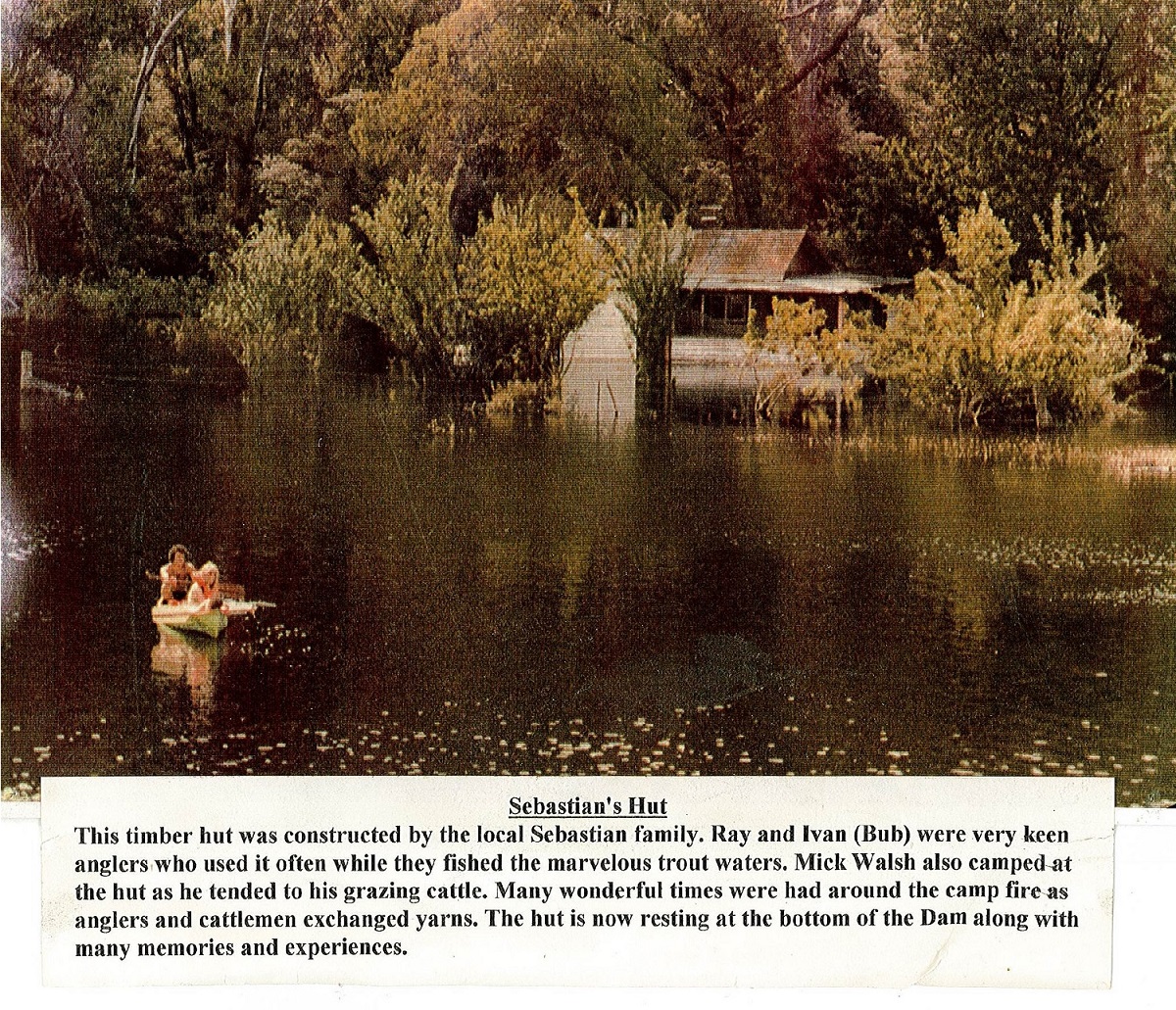About Dartmouth
 The original township of Dartmouth was at the junction of the Dart and Mitta Rivers, six miles upstream of the existing township via a bridle track. In 1870 the town was primarily established to provide provisions to gold miners operating along the lower and upper parts of the Dart River. The Murtagh and Crawford families managed hotels and were engaged in breeding cattle and milking cows. The milk was packed on horses to the Eskdale Butter Factory. The old township had a butcher shop, hotel, cemetery, general store, and school.
The original township of Dartmouth was at the junction of the Dart and Mitta Rivers, six miles upstream of the existing township via a bridle track. In 1870 the town was primarily established to provide provisions to gold miners operating along the lower and upper parts of the Dart River. The Murtagh and Crawford families managed hotels and were engaged in breeding cattle and milking cows. The milk was packed on horses to the Eskdale Butter Factory. The old township had a butcher shop, hotel, cemetery, general store, and school.
The cost of transporting the gold out of the area was prohibitive so by 1906, when the Crawford Hotel burned down, most of the miner had left the area. The Murtagh family operated a hotel until 1916, and continued to farm their 50 acres until they left in 1938. Once the Dam was complete in 1979, the old mining town was submerged.
In April 1972, the 3 State Governments and the Commonwealth ratified an agreement to construct Lake Dartmouth. Work on the project began in 1973 and was completed in 1979. A township was built for the workers at Banimboola, and the new town was named Dartmouth. The land for the township and Pondage Dam had to be compulsorily acquired from the Isaac Scales, who had an established beef cattle enterprise in the area.
In April 1972, the 3 State Governments and the Commonwealth ratified an agreement to construct Lake Dartmouth. Work on the project began in 1973 and was completed in 1979. A township was built for the workers at Banimboola, and the new town was named Dartmouth. The land for the township and Pondage Dam had to be compulsorily acquired from the Isaac Scales, who had an established beef cattle enterprise in the area.
The Dartmouth Dam embankment is the largest earth rock wall in the southern hemisphere. It is 180 metres high and the wall consists of 10.5 million cubic metres of rock and clay. The dam filled faster than anticipated and created a spectacular sight when the water spilled over the cascades in July 1990, October 1992 and October 1993. Two hydro power stations have also been constructed on Lakes Dartmouth and Banimboola, providing green energy.
During construction of the Dam, Dartmouth had a population of approximately 1800 people. There were 122 houses, three Caravan Parks, and single men’s quarters. The town centre contained a licensed supermarket, newsagent, hairdresser, post-office, butcher shop, milk bar, medical rooms and a TAB. A licensed canteen and cinema provided a place to relax after work. Dances and functions were held in the Community Hall. The Dartmouth school had 180 pupils, and families in the township formed tennis, basketball, cricket and football teams.
On completion of the dam in 1979, the population diminished as the work force left, leaving just a handful of maintenance employees and their families. Houses were tendered for removal or sold on site. The town was referred to as a “ghost town” during this particular time. In 1986 the Dartmouth School closed.
In 1984, the Sydney based Lake Dartmouth Corporation purchased the vacant land and town centre as a package. Three bedroom cottages were refurbished, the Caravan Park upgraded and a Motel was built to encourage tourism. A tourist information and souvenir shop, hotel bistro, coffee shop and post office were located in the central complex.
Today, there is a population of approximately 90 permanent residents in Dartmouth. The two major employers in the town are The Dartmouth Pub and Motor Inn, and Goulburn Murray Water. The town is a renowned trout fishing area and is currently experiencing housing and business growth.
On completion of the dam in 1979, the population diminished as the work force left, leaving just a handful of maintenance employees and their families. Houses were tendered for removal or sold on site. The town was referred to as a “ghost town” during this particular time. In 1986 the Dartmouth School closed.
In 1984, the Sydney based Lake Dartmouth Corporation purchased the vacant land and town centre as a package. Three bedroom cottages were refurbished, the Caravan Park upgraded and a Motel was built to encourage tourism. A tourist information and souvenir shop, hotel bistro, coffee shop and post office were located in the central complex.
Today, there is a population of approximately 115 permanent residents in Dartmouth. The two major employers in the town are The Dartmouth Pub and Motor Inn, and Goulburn Murray Water. The town is a renowned trout fishing area and is currently experiencing housing and business growth.
General
Dartmouth Dam impounds the waters of the Mitta Mitta River about 24km from the township of Mitta Mitta in north-eastern Victoria. It is the largest dam in Victoria and the highest structure of its kind in Australia. When full, the dam stores 4,000,000ML of high quality water.
The prime purpose of the Dam is to supplement releases from the Lake Hume and increase supplies to the Murray River system in dry seasons. The high quality water released from the dam, to the Murray River, also helps to reduce salinity in the downstream reaches.
Construction
Construction of the dam began in 1972 and was completed in 1979 by the State Rivers and Water Supply Commission, on behalf of the Murray Darling Basin Commission – the authority responsible for regulating the waters of the Murray River. The cost in 1979 was $139 million and was shared equally by the Commonwealth and the States of Victoria, New South Wales and South Australia.
Recreation
Lake Dartmouth is a favourite fishing location, with Trout and Macquarie Perch the main attraction. The nearby township of Dartmouth was built to house the construction workers and their families. A number of these houses have been refurbished as privately owned self contained lodges and many are available to rent. There is also motel accommodation and a caravan park with a general store. The Dartmouth Pub Complex incorporates as Coffee Shop, Takeaway Shop, General Store with fishing tackle and local information and Post Office as well as the at hotel and conference rooms. The Dartmouth Hall has a heritage display and Book shop
Mining
Mines were operation along the Lower & Upper parts of the Dart River in 1870’s. The Mascotta line, situated in the Upper Dart, realised yields of between 1-6 oz per ton, however the remoteness of the field and the cost extraction made mining on the Dart doomed to failure. The only access to the Dart fields was along a bridle track from Cravensville, some 20 miles. Some of the mines included the” Alpine Star”, “Glengarry Mine” the “Moscotte Mine”, and the “hidden Treasure”. The transportation of the quartz to the battery was also an expensive process. Quartz rock taken from the Lower Dartmines was transported to Larsens Creek Battery where it was crushed by the stamper. Some of the mines on the Lower Dart include “ The struck Oil”, the”Golden Eagle Reef” the “Sperm whale Reef”, and the” Morning Star”. The ore was transported to the battery by horse back or railway. The mines Department had a diamond drill and engine packed into Green’s Creek from Granite Flat, over 35 miles Alexander Cardwell and Laurence Moncrieff were commissioned to carry the equipment in. There was also a battery at Mckay’s Creek where several reefs were worked. Most of the mines in the Dart were abandoned by 1906 because of expense.
The Dart school opened in 1909, it only remained open till 1912 because of low attendance. Children could not often attend school because of the flood swollen Mitta Mitta River.
When the mining faded only the Crawford’s and the Murtagh’s remained at Dartmouth. Raymond Murtagh grazed cattle in the area and sent cream to the Eskdale Butter Factory in special cream can’s which could pack on a horse. In April 1942 Murtagh’s home was destroyed by fire. The old town of Dart is marked by bouy on the Lake. Directly below the bouy is Sebastians hut.
Dartmouth Dam
How, Where, When & Why
How?
The 180 m high embankment at Dartmouth consists of 14 100 000 cubic meters of zoned earth and rock fill. It has crest a length of 670 m and a base width of 700 m.
A rock quarry on the left hand side of the river gorge provided much of the embankment materials. This quarry now forms the spillway through which floodwaters will pass when the Dam is full. A 91.9 m long concrete over fall wall has been constructed to form the crest of the spillway.
Water can be released through either of the two tunnels. One is situated with an inlet at a relatively high level on the left abutment and is connected to a 150 MW power station at the toe of the dam. When ever possible, releases for irrigation are made through the power station in order that advantage can be taken of the high energy of the stored water. Hydro- electricity which is generated from the 150 megawatt power station, provides around 330 million kilowatt-hours of power to Victoria.
Where?
Dartmouth Dam impounds the water of the Mitta Mitta River about 24 Km from the township of Mitta in the North-East Victoria. The township of Dartmouth was build to house the work force for the construction of the Dartmouth Dam. It is the Largest Dam in Victoria and the highest structure 4,000,000 ML of high quality water from the surrounding alpine areas of Victoria.

Why?
The Dam was constructed for the prime purpose of storing water for irrigation, stock and domestic use in New South Wales, Victoria and South Australia. In dry season, it supplements releases from Lake Hume and increases supplies to the Murray River system. When high quality water is released from the Dam to the Murray River, this helps to reduce salinity in the downstream reaches.
Statistics
Reservoir capacity 4,000,000 ML
7 ½ times larger than Sydney Harbour
Surface Area 6 300 ha
Full supply level 486 m (ASL)
Catchment area 3 600 Km
Embankment
– height 180 m
– length (of crest) 670 m
When?
Investigations for a Dam on the Mitta Mitta river were first undertaken many years ago and during the 1967/70 period. Dartmouth was ratified by four governments concerned on the 1st April 1972. Construction of the Dam began in 1973 and was completed in 1979 by the Rural Water Corporation, on behalf of the River Murray Commission – the authority responsible for regulating the waters of the Murray River. The cost in 1979 was $139 million and was shared equally by the Commonwealth and the States of Victoria, N.S.W. and South Australia.
Scenic drives & points of interest in the Mitta Mitta Valley.
Mitta Mitta
The quaint little township of Mitta Mitta nestles snugly into the mountains just 18Km from Dartmouth. The town boasts a General Store, Hotel, Golf Course, Roman Catholic Church, Uniting Church and a Primary School. The Mitta Mitta township is situated where the Snowy Creek and the Mitta River meet, hence the name ”Mitta Mitta”, which is Aboriginal name for ‘the meeting of the waters’. The streams and river have been renowned for years for being some of the best trout fishing country in the North-East. The Pioneer Mine can also be found at Mitta Mitta. The Mine was opened in 1864 and produced 14,186 oz’s of gold over the years. It now stands as a monument to the great pioneers of the mining era.
Eskdale
As you journey to Dartmouth you will pass through the neat little town of Eskdale. A large General Store, Hotel, Café, Churches, Primary School and a Swimming Pool are situated there. Little Snowy Creek is excellent fly fishing water. Cod can be caught in the River. The Eskdale Trout Farm can be found approximately 2 km along the Little Snowy Creek Road, (beside the Swimming Pool is located behind the Primary School and visitor are welcome to use this facility for a small fee.
Granite Flat
Granite Flat is situated approximately 18km from Mitta Mitta on the Omeo Highway towards Omeo. In 1863, Granite Flat was a bustling gold mining town which employed between 500 and 600 men. The cemetery is a stark reminder of the endeavours of days gone by. The town had Hotel, Stores, School, and many houses to accommodate the population. The only reminder of this heritage is a small brick Church standing alone at the foot of the hills. The Catholic Church was the first brick Catholic Church build in Victoria. The Granite Flat property is owned by the Walsh Family who have been operating the land since 1914.
Tallangatta
The Hume Weir is the main attraction of the waterside town of Tallangatta. Tallangatta is approximately 1 hours drive from Dartmouth and has 2 Hotel, several shop,a Motel, Churches, Primary and High School. Centrally located is beautifully presented gardens and picnic areas. Water Skiing, Wind Surfing and swimming are very popular.
It is a very pleasant drive through the Mitta Valley from Dartmouth and well worth the effort.



